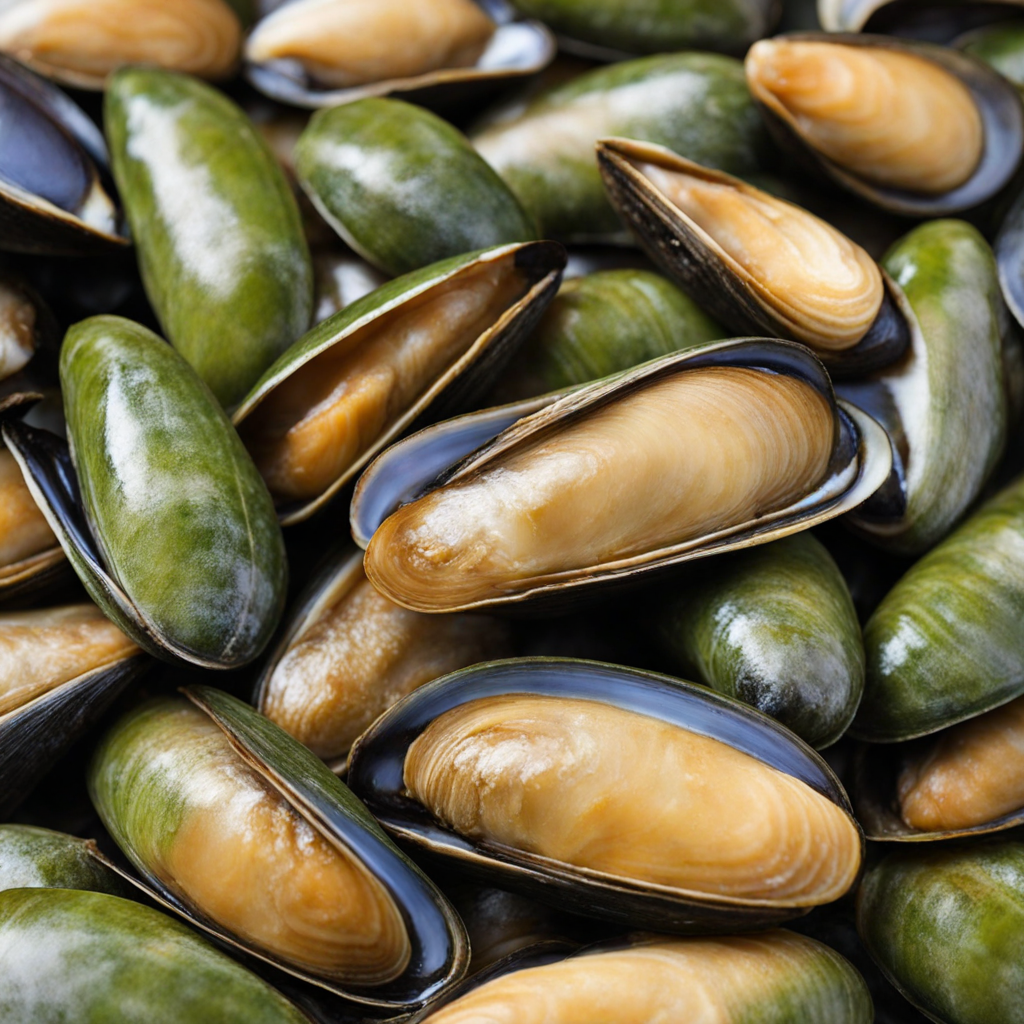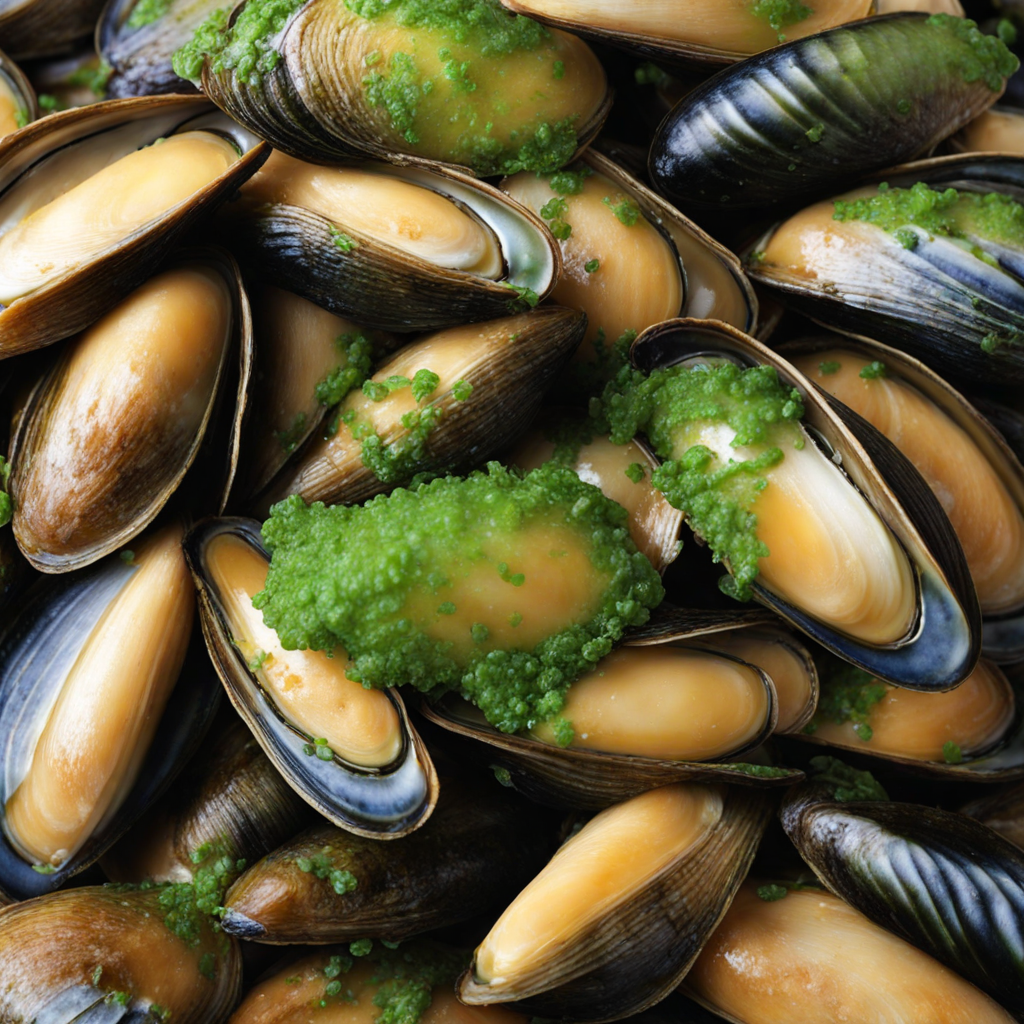Green-lipped Mussel
The Green-lipped Mussel, scientifically known as Perna canaliculus, is a unique bivalve mollusk native to the pristine waters of New Zealand. This remarkable shellfish is named for its striking green-edged shell, which sets it apart from other mussel species. Historically, the Green-lipped Mussel has been an integral part of Māori culture for centuries, serving not only as a food source but also as a component in traditional medicine. Māori tribes harvested these mussels along the rugged coastlines of Aotearoa (New Zealand) long before European settlers arrived, utilizing them in feasts and rituals, demonstrating their importance in indigenous culinary practices. Flavor-wise, the Green-lipped Mussel offers a distinctive taste that is both sweet and briny, with a tender yet slightly firm texture. The flavor profile is enhanced by the pristine marine environment in which they thrive, absorbing the essence of the nutrient-rich waters. When cooked, these mussels exude a subtle oceanic aroma, reminiscent of the sea, making them a preferred choice for seafood enthusiasts. Their unique taste stands out in various culinary applications, lending itself well to a variety of dishes without being overpowering. Preparation of Green-lipped Mussels is versatile, allowing for numerous cooking methods that highlight their natural flavors. Common techniques include steaming, grilling, and baking. When steaming, the mussels are typically placed in a pot with a small amount of water or broth and covered to cook until they open, usually within
How It Became This Dish
The Green-Lipped Mussel: A Culinary Treasure from New Zealand #### Origins and Habitat The green-lipped mussel, scientifically known as *Perna canaliculus*, is a bivalve mollusk native to the coastal waters of New Zealand. Its vibrant green-edged shells not only contribute to its unique aesthetic appeal but also have made it a significant part of New Zealand's marine ecosystem and culinary landscape. These mussels thrive in the nutrient-rich waters of the country, particularly in the Marlborough Sounds, where the mix of fresh and saltwater creates an ideal environment for their growth. The green-lipped mussel is believed to have been consumed by the Māori, the indigenous people of New Zealand, for centuries. The Māori utilized these mussels as a vital food source, often harvesting them from the intertidal zones and rocky shores. They also recognized the mussel's nutritional value, which is rich in protein, omega-3 fatty acids, and various vitamins and minerals, making it a staple in the traditional Māori diet. #### Cultural Significance In Māori culture, the green-lipped mussel holds more than just nutritional value; it is embedded in the spiritual and social fabric of the community. The act of harvesting mussels is often a communal activity, fostering relationships and strengthening bonds among family and friends. The traditional practice of gathering these shellfish is intertwined with cultural rituals and stories passed down through generations. Māori legends often feature the sea and its bounty, including the green-lipped mussel, which symbolizes not just sustenance but also a connection to the land and sea. The mussel is sometimes associated with the ocean goddess, Hine-moana, who represents the life-giving aspects of the sea. This reverence for marine life is reflected in the sustainable harvesting practices adopted by Māori, ensuring that they maintain a balance with nature while honoring their ancestral traditions. #### Development Over Time As European settlers arrived in the 19th century, they were introduced to the green-lipped mussel and its culinary potential. Initially, the mussel was harvested for local consumption, but its popularity began to grow beyond New Zealand's shores. The introduction of aquaculture in the 1970s revolutionized the green-lipped mussel industry. New Zealand's favorable climate, clean waters, and innovative farming techniques allowed for large-scale cultivation while maintaining environmental sustainability. The farming of green-lipped mussels involves suspending ropes in the water, where larvae settle and grow into mature mussels. This method not only ensures a steady supply but also minimizes the impact on natural populations, making it an eco-friendly approach to seafood production. The green-lipped mussel quickly became a sought-after delicacy, known for its sweet, tender flesh and unique flavor profile. #### Culinary Applications and Global Recognition The culinary versatility of the green-lipped mussel has contributed to its rising popularity in international cuisine. Chefs around the world have embraced this ingredient, incorporating it into a variety of dishes, from simple steamed mussels with garlic and white wine to more elaborate preparations like mussel chowder or seafood paella. The distinct flavor of the green-lipped mussel, often described as briny and slightly sweet, pairs well with a wide range of ingredients, making it a favorite among both home cooks and professional chefs. In the late 20th century, the green-lipped mussel gained global recognition not only for its culinary qualities but also for its health benefits. Research began to uncover the anti-inflammatory properties of the mussel, leading to its use in dietary supplements and health products. The rich omega-3 fatty acids found in green-lipped mussels have been linked to heart health and overall wellness, further enhancing their appeal beyond the culinary sphere. As demand grew, New Zealand's green-lipped mussel industry adapted to meet the global market. The establishment of export markets in Asia, Europe, and North America allowed New Zealand to position itself as a leading supplier of high-quality mussels. The green-lipped mussel quickly became one of New Zealand's most valuable seafood exports, contributing significantly to the country's economy. #### Sustainability and Future Prospects Despite its success, the green-lipped mussel industry faces challenges, including environmental concerns and the impacts of climate change on marine ecosystems. However, the commitment to sustainability remains a cornerstone of New Zealand’s aquaculture practices. The industry is actively involved in research and development to enhance farming methods, reduce environmental footprints, and ensure the continued health of marine habitats. Furthermore, ongoing efforts to educate consumers about sustainable seafood choices have led to increased awareness and demand for responsibly sourced green-lipped mussels. Initiatives to promote eco-labeling and certifications are helping consumers make informed decisions, supporting both local communities and the preservation of marine environments. #### Conclusion The journey of the green-lipped mussel from the coastal waters of New Zealand to tables around the world is a testament to its rich cultural heritage and culinary significance. As a symbol of Māori traditions and a cornerstone of New Zealand's seafood industry, the green-lipped mussel offers a unique blend of history, flavor, and sustainability. With its nutritional benefits and adaptability in the kitchen, the green-lipped mussel is poised to remain a beloved ingredient in both traditional and contemporary cuisine. As we look to the future, the focus on sustainable practices and environmental stewardship will ensure that this remarkable shellfish continues to thrive, nourishing generations to come while honoring its deep cultural roots. In every bite of this exquisite delicacy, one can taste the ocean's bounty and the rich history of the land from which it hails, making the green-lipped mussel not just a food, but a story worth savoring.
You may like
Discover local flavors from New Zealand







